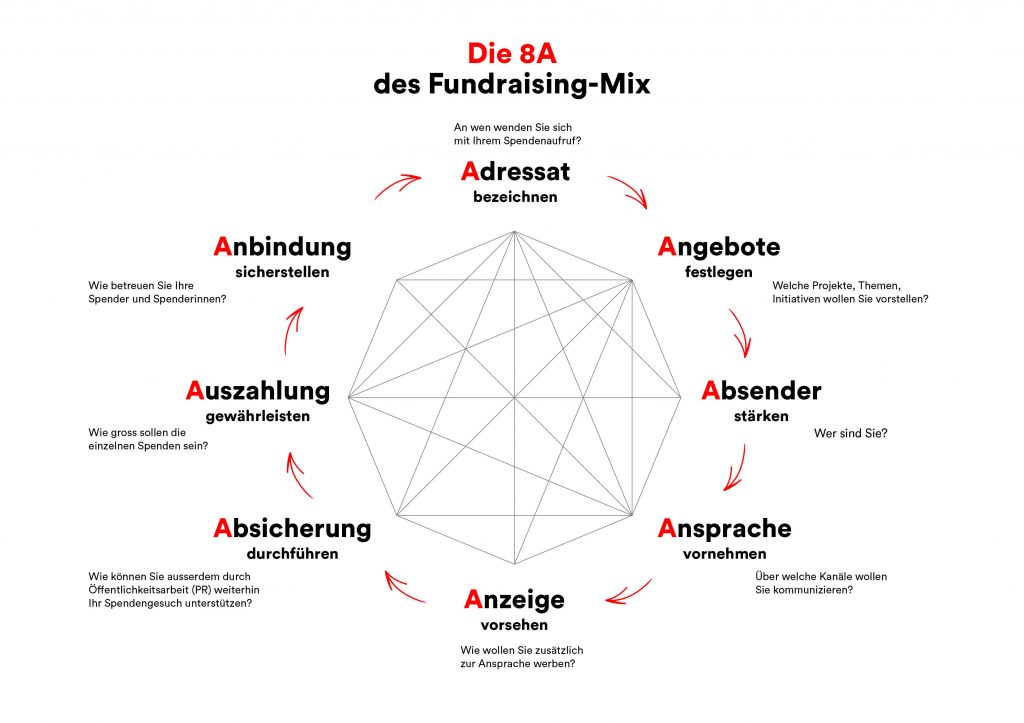
How to Create a Successful Fundraising Concept
A great project, an innovative idea, an initiative worth supporting: every day, plans and projects for a fairer and more responsible society come out of the world of non-profit work. But the so-called case , the objective, alone is no guarantee for a successful project. Similar parameters apply to fundraising and marketing in the private sector. A well thought-out fundraising concept is the key to effective fundraising, more reach and the successful implementation of a project.
Less is More: The Golden Rule for a Successful Fundraising Strategy
The possibilities of fundraising in Switzerland are so diverse that we have dedicated a separate article to this topic. Whether it’s traditional fundraising or digital fundraising, as is often the case: “less is more” when it comes to fundraising. One is tempted to exhaust all possibilities and try all approaches. However, playing on all channels usually does not bring the desired success, but on the contrary a rude awakening.
The coordination of all these measures overwhelms even professional fundraising teams of large organizations. The results often leave much to be desired. On the one hand, because half-hearted measures are seldom really convincing and donors do not feel that they are being listened to. Second, because not every fundraising channel is appropriate for every project and every contact.
So how do you go about it? With a strategically structured fundraising concept, you create a roadmap for your donation acquisition. Define a fundraising mix and fundraising submarkets that make sense for your specific project. You should focus on one or two measures. If you select them carefully, you will make a decisive contribution to the success of the project.
With Eight Key Points to a Fundraising Concept
The efficient and structured way to a successful fundraising concept leads you along eight key points (NonproCons Fundraising Systems NFS). Define priorities and assign tasks and resources to the targeted output. Once you have clarified these aspects for yourself and your fundraising project, a large part of the fundraising concept is already complete.
- Addressee
Who are you addressing with your appeal for donations? Determine which donors you want to target. Define the dialog groups according to their personal and functional characteristics. Personal are characteristics such as age, gender, subject affinity and income. Functional characteristics relate to donor activity: do you want to target first-time or new donors, major donors, multiple donors, etc.?
- Offers
Which projects, topics, initiatives do you want to present? The offer strategy is always dependent on the addressee. Companies, for example, should receive different offers than private donors. Focus on projects that are attractive to the addressee.
- Sender
Who are you? As a non-profit organization or initiative, your image, brand and the values you convey are crucial. Donors need to perceive you as reputable, trustworthy and unique.
- Appeal
Which channels do you want to use to communicate? Define the tools and media for your donor outreach and project presentation.
- Display
How do you plan to advertise in addition to appealing? Decide whether and to what extent you want to accompany your fundraising appeal with advertising. This can cost a lot of money under certain circumstances. You may be able to get influencers, celebrities or magazines interested in your cause so that they advertise for you for free.
- Safeguarding
In addition, how can you continue to support your donation request through public relations (PR)?
- Payment
How large should the individual donations be? Set an amount as a suggestion that donors can use as a guide. If necessary, also specify a minimum amount and possible scales.
- Connection
How do you take care of your donors? Through thank-you notes, newsletters, project information or an annual report, your supporters receive valuable information about the impact of their donations. This increases the likelihood that they will be happy to contribute again when the call for donations is renewed.

Planning & Structure: Think About the Implementation of Your Fundraising Concept!
As you go through the eight key points, implementation ideas and associated tasks and needed resources will automatically come to mind. Think these aspects further, because a fundraising concept is only good if it can be implemented. What resources need to be in place, what tasks need to be completed in order to achieve the goals that have been set? Is that realistic?
First, plan the tasks, because this will determine the resources needed. The resources are primarily time, money, know-how and people. These, in turn, are interdependent. If one hires a person with expertise, the points of time and know-how are served. If this person has to be paid, there may be a new tension with regard to the budget. An economic weighing of costs and benefits is essential here.
What Determines the Success or Failure of Your Fundraising Concept?
In addition to the content and strategic aspects, form and function as well as the process also determine whether your fundraising strategy ultimately leads to success. If you take these points into account, nothing will stand in the way of the successful implementation of your fundraising concept:
- A comprehensive and unbiased analysis of the status quo, the definition of fundraising guiding principles and a strategic fundamental decision are usually at the beginning of every new fundraising concept.
- Once the fundraising strategy has been defined on the basis of the eight key points, strategic fundraising controlling leads to orderly and efficient implementation: instruments, processes and responsibilities as well as a reporting system are set up. In all cases, risk assessment and fundraising risk management should be established.
- To ensure that the fundraising concept is comprehensible at all times and for all parties involved, it should be available as a written document. This document should be written and structured simply, organized in a meaningful way, and accessible to all contributors. In this way, the fundraising concept becomes a concrete project plan that even newcomers can use for orientation.
- Important when creating the fundraising strategy: a fundraising concept is the directly implementable working basis for your fundraising project. Internally, it informs all stakeholders as well as management positions about the approach, planned processes and measures, thus promoting a deep common understanding. It ensures that fundraising is consistent with and supports the purpose of the organization. The concept should demonstrate that fundraising is compatible with all processes of the organization and harmonizes with management levels as well as operational activities.
Don’t forget: A Sound Fundraising Concept Requires Collaboration and Flexibility.
Already during the development of a fundraising concept, it is important to consider some points. For example, everyone involved in fundraising should also be involved in the concept. The board of directors and other management bodies assume decision-making responsibility just as much as operational actors.
Also important: a fundraising concept is not created within a week and then fixed unchangeably. Rather, it is a long-term process in which readjustments, additions and cuts are made even during implementation. It is important to remain flexible in order to be able to react quickly to unexpected developments.
Is it Worth the Effort? Do I Need a Fundraising Concept?
At first, the effort required to create a fundraising concept may seem disproportionate. But even for small organizations and initiatives, it is advisable to strategically plan and record processes. This facilitates the work immensely and makes processes transparent. The supposed initial extra effort ensures a smooth flow in the ongoing process.
With a fundraising concept, you don’t waste valuable time searching for the right contact persons or central documents, because these are already systematically documented. Also, you do not have to inform each new employee individually about the process. Likewise, tasks are not forgotten or duplicated because responsibilities are clearly defined. In addition, a fundraising concept prevents measures from suddenly becoming impossible to implement due to a lack of the necessary resources.
And last but not least: a fundraising concept ensures you have a learning curve. Errors or inconsistencies in the strategy are revealed, can be corrected, recorded and avoided from the beginning next time. If you develop a comprehensive fundraising concept even as a small non-profit organization, it will serve as a template for future campaigns. So with your fundraising concept, you already have a solid foundation that can be easily expanded for future larger projects.












